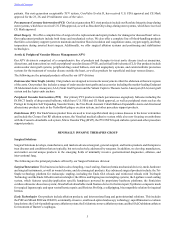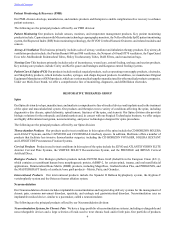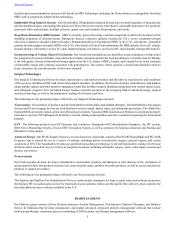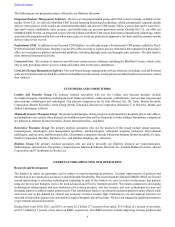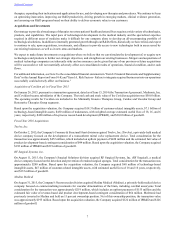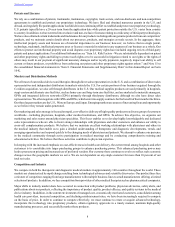Medtronic 2016 Annual Report Download - page 16
Download and view the complete annual report
Please find page 16 of the 2016 Medtronic annual report below. You can navigate through the pages in the report by either clicking on the pages listed below, or by using the keyword search tool below to find specific information within the annual report.
Table of Contents
13
State and local authorities increasingly focus on the importance of protecting individuals from identity theft, with a significant
number of states enacting laws requiring businesses to notify individuals of security breaches involving personal information.
State consumer protection laws may also apply to privacy and security practices related to personally identifiable information,
including information related to consumers and care providers.
We are also impacted by the privacy requirements of countries outside the United States. Privacy standards in Europe and Asia
are becoming increasingly strict. Enforcement action and financial penalties related to privacy in the E.U. are growing, and new
laws and restrictions are being passed. In April of 2016, the European Council and the Parliament adopted the new General Data
Protection Regulation, which sets demanding requirements for the management of individually identifiable data in the E.U.
The management of cross border transfers of information among and outside of E.U. member countries is becoming more complex,
which may complicate our clinical research activities, as well as product offerings that involve transmission or use of clinical data.
China and Russia have passed so-called “data localization” laws, which require multi-national companies that store certain
individually identifiable data on their citizens to maintain that data on servers located in their country. Restrictions on transfer or
processing of that data may apply as well. The restrictions may complicate our operations in those countries, adding complexity
and additional management and oversight needs, and the Chinese and Russian governments are still clarifying how they will apply
and enforce these laws.
Cost Containment Initiatives
Government and private sector initiatives to limit the growth of health care costs, including price regulation, competitive pricing,
bidding and tender mechanics, coverage and payment policies, comparative effectiveness of therapies, technology assessments,
and managed-care arrangements, are continuing in many countries where we do business, including the U.S. These changes are
causing the marketplace to put increased emphasis on the delivery of more cost-effective medical devices and therapies. Government
programs, including Medicare and Medicaid, private health care insurance, and managed-care plans have attempted to control
costs by limiting the amount of reimbursement they will pay for particular procedures or treatments, tying reimbursement to
outcomes, shifting to population health management, and other mechanisms designed to constrain utilization and contain costs.
Hospitals, which purchase implants, are also seeking to reduce costs through a variety of mechanisms, including, for example,
creating centralized purchasing functions that set pricing and in some cases limiting the number of vendors that can participate in
the purchasing program. Hospitals are also aligning interests with physicians through employment and other arrangements, such
as gainsharing, where a hospital agrees with physicians to share any realized cost savings resulting from the physicians’ collective
change in practice patterns such as standardization of devices where medically appropriate. This has created an increasing level
of price sensitivity among customers for our products.
Some third-party payers must also approve coverage and set reimbursement levels for new or innovative devices or therapies
before they will reimburse health care providers who use the medical devices or therapies. Even though a new medical device
may have been cleared for commercial distribution, we may find limited demand for the device until coverage and sufficient
reimbursement levels have been obtained from governmental and private third-party payers. In addition, some private third-party
payers require that certain procedures or that the use of certain products be authorized in advance as a condition of reimbursement.
International examples of cost containment initiatives and health care reforms in markets significant to Medtronic's business
include Japan, where the government reviews reimbursement rate benchmarks every two years, which may significantly reduce
reimbursement for procedures using our medical devices or deny coverage for those procedures. As a result of our manufacturing
efficiencies, cost controls and other cost-savings initiatives, we believe we are well-positioned to respond to changes resulting
from the worldwide trend toward cost-containment; however, uncertainty remains as to the nature of any future legislation, new
or changed coverage and reimbursement government or private payer policies or decisions, or other reforms, making it difficult
for us to predict the potential impact of cost-containment trends on future operating results.
Regulations Governing Reimbursement
The delivery of our devices is subject to regulation by HHS and comparable state and non-U.S. agencies responsible for
reimbursement and regulation of health care items and services. U.S. laws and regulations are imposed primarily in connection
with the Medicare and Medicaid programs, as well as the government’s interest in regulating the quality and cost of health care.
Other governments also impose regulations in connection with their health care reimbursement programs and the delivery of health
care items and services.
U.S. federal health care laws apply when we or customers submit claims for items or services that are reimbursed under Medicare,
Medicaid, or other federally-funded health care programs. The principal U.S. federal laws include: (1) the Anti-kickback Statute,
which prohibits offers to pay or receive remuneration of any kind for the purpose of purchasing, ordering, recommending making
referrals to items or services reimbursable by a federal health care program; (2) the False Claims Act which prohibits the submission
of false or otherwise improper claims for payment to a federally-funded health care program, including claims resulting from a
violation of the Anti-kickback Statute; (3) the Stark law, which prohibits physicians from referring Medicare or Medicaid patients


